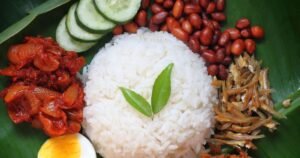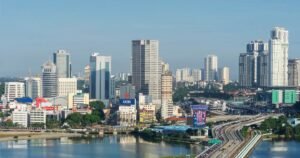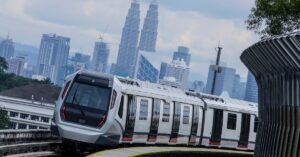Introduction to Malaysia’s Climate
Malaysia is a Southeast Asian country characterized by a tropical climate, which significantly influences the weather patterns experienced throughout the year. This climatic condition, marked by high humidity and consistent temperatures ranging from 77°F to 95°F (25°C to 35°C), varies regionally due to Malaysia’s geographical diversity. The country is split primarily into two main regions: Peninsular Malaysia and East Malaysia, each offering distinct weather conditions that can affect travel plans.

The climate in Malaysia can be broadly categorized into two monsoon seasons: the Southwest Monsoon, typically occurring from May to September, and the Northeast Monsoon, which prevails from November to March. The Southwest Monsoon usually brings dry weather to the western coast of Peninsular Malaysia, making it an ideal period for outdoor activities and beach holidays. Conversely, during the Northeast Monsoon, the eastern states, particularly in the South China Sea, experience heavy rainfall, leading to potential disruptions for travelers seeking sunny holiday experiences.

Understanding Malaysia’s climate is essential for planning your holidays. While the wet season may deter some tourists, it can also present unique opportunities to explore Malaysia’s lush rainforests and vibrant wildlife, as well as to participate in cultural events and festivals that flourish during this time. Moreover, the general weather patterns indicate that certain months might offer a more favorable environment for specific activities, such as diving, jungle trekking, or visiting cities. Consequently, this knowledge enables prospective travelers to select dates that align with their desired holiday experiences, ultimately enhancing their enjoyment and satisfaction during their stay in Malaysia.
Understanding the Monsoon Seasons
Malaysia is characterized by a tropical rainforest climate, largely influenced by its geographical location near the Equator and its distinct monsoon seasons. The country experiences two primary monsoon systems: the Southwest Monsoon and the Northeast Monsoon. Each of these monsoons brings unique weather patterns that significantly affect rainfall distribution and travel conditions across different regions, notably the west and east coasts.

The Southwest Monsoon typically occurs from May to September. During this period, the west coast of Malaysia, which includes popular destinations such as Kuala Lumpur and Penang, tends to experience drier conditions. Conversely, the east coast, including places like Tioman Island and the Perhentian Islands, faces heavy rainfall and rough seas, which can disrupt travel plans. Therefore, while the west coast is more favorable for holiday planning during these months, the east coast is best avoided.

Following the Southwest Monsoon, the inter-monsoon period takes place from September to November. This transitional phase is marked by unpredictable weather patterns, leading to occasional thunderstorms and scattered rain across the country. While it may not be entirely devoid of rainfall, this period still presents some opportunities for travel, although travelers should remain flexible in their plans. Popular activities such as excursions and beach fun can be enjoyed; however, travelers should be prepared for sudden changes in weather conditions.

The Northeast Monsoon runs from November to March, delivering substantial rainfall predominantly to the east coast, while the west coast remains relatively dry. This monsoon is known for its potential to cause flooding in certain regions, making it essential for tourists to plan their trips accordingly. In summary, understanding the monsoon seasons and their implications is vital for travelers looking to plan holidays in Malaysia. Each season offers unique experiences, but awareness of rainfall patterns can significantly enhance trip planning and leisure activities.
Best Time to Visit for Beach Holidays
Malaysia is renowned for its stunning coastline and idyllic beach destinations, making it a perfect choice for beach holidays. When contemplating a visit for seaside enjoyment, it is essential to consider the climatic conditions that influence these picturesque locations. The best months to enjoy a beach holiday in Malaysia typically range from March to October. During this period, popular destinations such as Langkawi and the Perhentian Islands experience favorable weather, characterized by clear skies and minimal rainfall.

Langkawi, known for its pristine beaches and vibrant marine life, is an excellent place to engage in a variety of coastal activities. Visitors can indulge in water sports, including jet-skiing, parasailing, and scuba diving. March to September marks the prime season for these activities, ensuring optimal conditions for both beginners and experienced enthusiasts. The warm and sunny weather during these months creates a perfect backdrop for sunbathing and relaxation on the beautiful shores of Pantai Cenang.
The Perhentian Islands, located off the northeastern coast of Malaysia, are equally appealing for beachgoers. The period between April and September is ideal for exploring these islands, where visitors can partake in snorkeling, diving, and vibrant island-hopping adventures. The underwater visibility is usually at its best during these months, allowing for an unforgettable experience as one explores the region’s diverse marine ecosystem.
Furthermore, it’s vital to be aware of the monsoon seasons that can disrupt beach activities. The northeast monsoon typically occurs from November to February, bringing heavy rains and strong winds. Therefore, planning beach holidays outside this period can enhance vacation experiences, allowing travelers to immerse themselves in the beauty and activities that Malaysia’s coastal areas have to offer.
Cultural Festivals and Events to Consider
Malaysia, a melting pot of diverse cultures and traditions, offers an array of vibrant cultural festivals throughout the year, making it an attractive destination for tourists seeking to immerse themselves in local customs. One of the prominent events is Hari Raya Aidilfitri, celebrated by the Malaysian Muslim community. This festival marks the end of Ramadan and showcases a rich tapestry of customs including communal prayers, family gatherings, and festive feasts. The atmosphere is filled with joy as families don traditional attire and visit each other’s homes, making it a perfect time for tourists to experience Malaysia’s warm hospitality.

Another significant cultural event is Chinese New Year, which typically falls between late January and mid-February. This festival is characterized by elaborate lion dances, vibrant parades, and the decoration of homes with red lanterns and floral arrangements. The festivities last for 15 days, culminating in the Lantern Festival. Tourists can engage in various traditional practices such as giving and receiving ‘angpows’ (red envelopes) and enjoying sumptuous dishes, making it a rich experience of Chinese heritage in Malaysia.
Moreover, Deepavali, the Festival of Lights, is celebrated by the Hindu community, usually in October or November. This festival symbolizes the victory of light over darkness and is marked by the decoration of homes with oil lamps and intricate rangoli designs. Celebrants often partake in prayers, fireworks, and family gatherings with an abundance of delicious sweets and snacks. Visitors during this time can witness the breathtaking sights and sounds of this festive period, providing a unique glimpse into the spiritual and cultural essence of Malaysian Hindu traditions.

By planning holidays around these enriching cultural festivals, tourists can gain a deeper understanding of Malaysia’s societal fabric while enjoying the festive cheer that envelops the nation. Each event presents a unique opportunity to experience the country’s diversity, offering a meaningful travel experience enriched by local traditions.
Adventure and Nature Activities by Season
Malaysia is renowned for its rich biodiversity, offering a myriad of opportunities for adventure and nature enthusiasts. The country’s diverse ecosystems, ranging from lush rainforests to rugged mountains, make it an ideal destination for activities such as hiking, jungle trekking, and wildlife watching. Each season presents unique advantages for exploring these natural wonders.
The dry season, typically from March to October, is considered the best time for hiking and trekking adventures. During these months, trails in popular national parks like Taman Negara and Endau-Rompin are more accessible and offer favorable weather conditions. The lower humidity and decreased rainfall improve the hiking experience, allowing trekkers to enjoy breathtaking views and an abundance of flora and fauna. Wildlife watching is particularly rewarding during this season, as animals are more active and visible in search of food and water.
In contrast, the wet season, which lasts from November to February, may deter some outdoor activities due to heavy rainfall, particularly on the west coast of Malaysia. However, this season also provides its own unique opportunities for nature lovers. The rejuvenation of the ecosystems after rain results in vibrant landscapes, and certain areas are ideal for observing migratory birds and the dramatic changes in wildlife behavior. Places like Kuala Selangor Nature Park become hotspots for birdwatching during this time.
Visitors interested in exploring Malaysia’s vast national parks should consider their availability and accessibility by season. While Taman Negara and Bako National Park remain great options year-round, others like Penang National Park may offer fewer services during the wet season. Planning is essential to ensure a fulfilling experience in Malaysia’s rich natural environment, providing the adventure and thrill that every nature lover seeks.
City Exploration: Urban Attractions by Season
When planning a holiday centered on city exploration in Malaysia, it is crucial to consider the climate and seasonal events that can enhance your experience in urban environments, particularly in vibrant cities like Kuala Lumpur and Penang. Generally, Malaysia has a tropical climate, characterized by high humidity and significant rainfall throughout the year. However, there are specific periods that stand out for urban exploration.

The best time to visit Kuala Lumpur is between December and February, during the peak tourist season when the weather is relatively cooler and less humid. During this period, the city hosts several festive events, including the Kuala Lumpur International Arts Festival, which showcases local and international talent through music, dance, and art exhibitions. An exploration of urban attractions like the iconic Petronas Twin Towers or the bustling Bukit Bintang shopping district is particularly enjoyable amidst the celebratory atmosphere.
From March to November, Kuala Lumpur experiences increased rainfall, especially during the monsoon season from May to September. While heavy showers are common, this is also when visitors can experience unique local festivals like the Hari Raya Aidilfitri, which offers an interesting cultural perspective for urban exploration. The rain may be inconvenient, but it also tends to clear the crowds, allowing a more intimate experience at popular sites, including Batu Caves and the Central Market.

In Penang, the ideal time for urban exploration is from December to February, aligning with its annual Penang Chinese New Year celebrations filled with vibrant festivities. Visitors can explore George Town’s stunning colonial architecture, vibrant street art, and the famous Penang food scene. Moreover, the month of July introduces the George Town Festival, making summer another appealing season for an enriching city experience.
Overall, understanding seasonal influences will greatly enhance your urban exploration in Malaysia’s cities, enriching your cultural experiences while enjoying the local festivities and attractions that define these urban landscapes.
Tips for Traveling During the Monsoon
Traveling to Malaysia during the monsoon season can be an adventurous experience, but it requires some careful planning to ensure a pleasant trip. The monsoon months typically span from May to September, bringing heavy rainfall and humidity. To navigate these weather challenges effectively, it is essential to consider certain tips that will enhance your travel experience.
First and foremost, packing wisely is crucial. Lightweight, quick-drying clothing made from breathable fabric is an excellent choice. Waterproof jackets and umbrellas are essentials that can significantly enhance comfort. Waterproof bags can also help protect your valuables and electronics from unexpected downpours. Moreover, sturdy waterproof footwear can make exploring wet landscapes much easier and safer.
Adjusting your travel itinerary is another valuable tip. It may become necessary to accommodate sudden weather changes that can impact outdoor activities. Rather than focusing solely on beach destinations or hill resorts, consider exploring Malaysia’s vibrant cities, where numerous indoor attractions await. Kuala Lumpur, for instance, offers a wealth of shopping malls and cultural venues such as the Petronas Twin Towers and the Islamic Arts Museum. Penang boasts a plethora of indoor cafes and art galleries that are inviting when the sun isn’t shining.
Additionally, taking part in local festivals or cultural events can provide unique experiences during the monsoon season. Participating in traditional celebrations allows you to connect with the local culture while enjoying the festive atmosphere, which is often heightened by the refreshing rains. When planning your activities, don’t hesitate to reach out to local tourism offices for current events or attractions that might be better suited for inclement weather.
By following these tips, travelers can enjoy all the beauty Malaysia offers, regardless of the rain. With a little foresight and flexibility in your plans, the monsoon can reveal a different, yet equally captivating side of this enchanting country.
Budgeting for Seasonal Travel in Malaysia
When planning a holiday in Malaysia, understanding the influence of seasons on pricing and availability is crucial for effective budgeting. The country experiences a tropical climate, divided mainly into two seasons: the wet season and the dry season. Each season not only dictates the weather conditions but also significantly impacts the costs associated with travel, accommodations, and activities.
Traveling during the peak seasons, which typically coincide with school holidays and festive periods, can lead to inflated prices. Accommodations in popular destinations such as Kuala Lumpur, Langkawi, and Penang often see a surge in charges, sometimes reaching 30% above the off-peak rates. Food, transportation, and activity costs tend to rise as well, owing to increased demand. Moreover, availability can become an issue, with many hotels and attractions fully booked during these periods.
Conversely, the off-peak season, usually falling between March and October, offers a more budget-friendly approach. Travelers have the opportunity to secure accommodation at lower prices, sometimes as much as 50% less than peak season rates. Additionally, flights can be significantly cheaper, and there is generally more flexibility in scheduling activities without the crowds. During this time, visitors can also take advantage of special promotions and discounts offered by businesses hoping to attract guests.
To optimize travel budgeting, it can be beneficial to conduct thorough research on upcoming events and festivals, as these can influence prices and availability. Creating a flexible itinerary allows travelers to adjust plans based on weather conditions or budget constraints. By carefully selecting travel dates and considering local effects on pricing, visitors can greatly enhance their overall experience while minimizing expenses during their Malaysian holiday.
Conclusion: Planning Your Perfect Holiday
Planning a holiday in Malaysia can indeed be an exciting endeavor, and understanding the various seasons is essential to optimizing the experience. Malaysia’s unique geography results in distinct weather patterns across different regions, significantly influencing the activities available and the cultural events that take place throughout the year. Armed with this knowledge, travelers can select the most suitable time to visit based on their interests and preferences.
For instance, if you are inclined toward beach holidays, the dry season, typically from December to March, may be ideal for enjoying the picturesque beaches of Langkawi or the Perhentian Islands. Conversely, the wet season offers a different allure, with fewer tourists and vibrant, lush landscapes, perfect for those who appreciate a quieter ambiance. Furthermore, Malaysia’s rich cultural tapestry—manifested in festivals such as Hari Raya, Chinese New Year, and Deepavali—invites visitors year-round, allowing for an immersive cultural experience that varies with the seasons.
Additionally, tailoring your travel based on the seasonal cuisine can greatly enhance your holiday. Malaysian food is diverse, and certain dishes are specific to particular times of the year, offering an authentic taste of local traditions. Thus, the planning of your holiday should encompass not only the climatic conditions but also the rich cultural experiences, seasonal festivities, and unique culinary offerings that Malaysia has to present.
In conclusion, with thoughtful preparation, it is evident that one can enjoy a remarkable holiday in Malaysia at any time of the year. The combination of favorable weather, exciting activities, and vibrant cultural experiences ensures unforgettable memories for all types of travelers. Whether you seek adventure, relaxation, or cultural enrichment, the keys to a successful holiday in Malaysia lie in understanding the nuances of its seasons and planning accordingly.
 Food, Kuala Lumpur
Food, Kuala LumpurJalan Alor Food Street AdventureExplore amazing flovours of streed food in Jalan Alor in the heart of Bukit BintangClick HereFoodcourt […]
 Food, Kuala Lumpur
Food, Kuala LumpurKuala Lumpur Food Courts: Where to Find Cheap Eats & Local Street Food in KL Shopping Malls in Kuala Lumpur […]
 Kuala Lumpur
Kuala LumpurThe Heritage Trail in Kuala Lumpur The Heritage in Kuala Lumpur explore some of the earliest buildings constructed in the […]
 Kuala Lumpur
Kuala Lumpur1. Shop at the Central Market Kuala Lumpur Find souvenirs, artifacts, modern art, handicrafts, batik, traditional clothing and crafts of […]
 Kuala Lumpur
Kuala LumpurWhen the tropical sun finally dips below the horizon in Kuala Lumpur, the city doesn’t go to sleep. Instead, it […]
 Malaysia, Roadtrips
Malaysia, RoadtripsThe Kuala Lumpur to Johor Bahru road trip in Malaysia is a great way to explore some amazing historical cities along […]
 Kuala Lumpur Hotels
Kuala Lumpur HotelsLooking for an affordable but quality hotel in the middle of Bukit Bintang? Centrally located in Kuala Lumpur’s vibrant Golden Triangle, Furama […]
 Kuala Lumpur
Kuala LumpurCentral Market Kuala Lumpur, or Pasar Seni it is popularly called is a traditional market that originated as a trading hub around the […]
 Kuala Lumpur
Kuala LumpurNestled in the heart of Kuala Lumpur, Bukit Bintang is the most popular location to stay and explore. Bukit Bintang […]
 Itinerary, Kuala Lumpur, Penang
Itinerary, Kuala Lumpur, PenangPenang is one of the most popular destinations in Malaysia for tourists because of its rich cultural history and amazing […]

